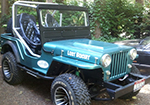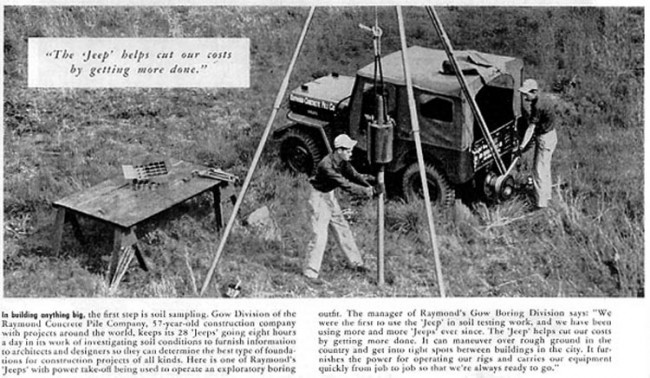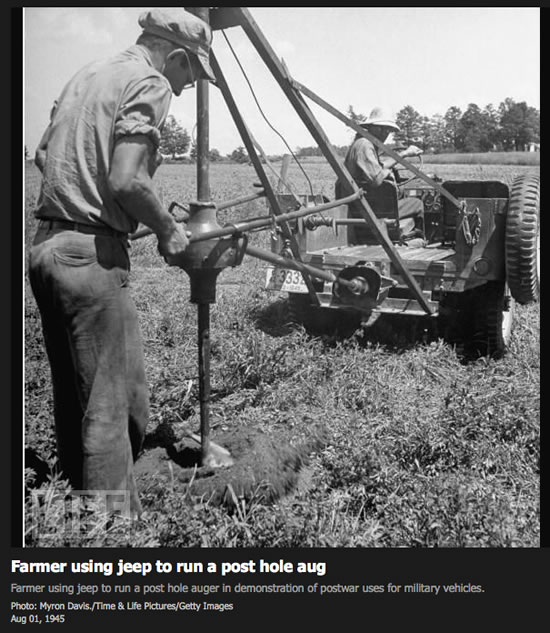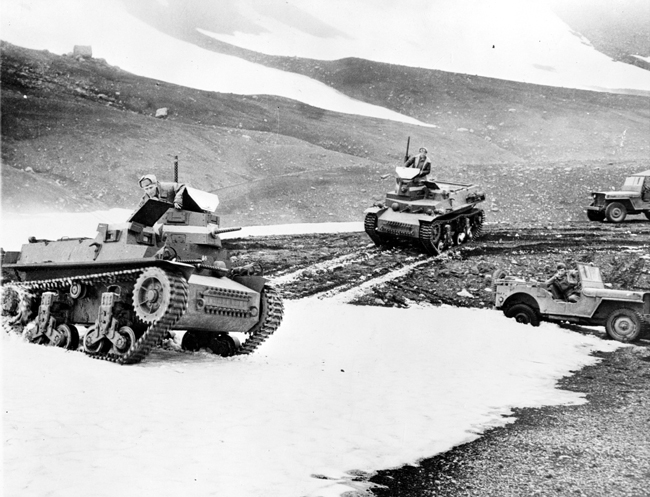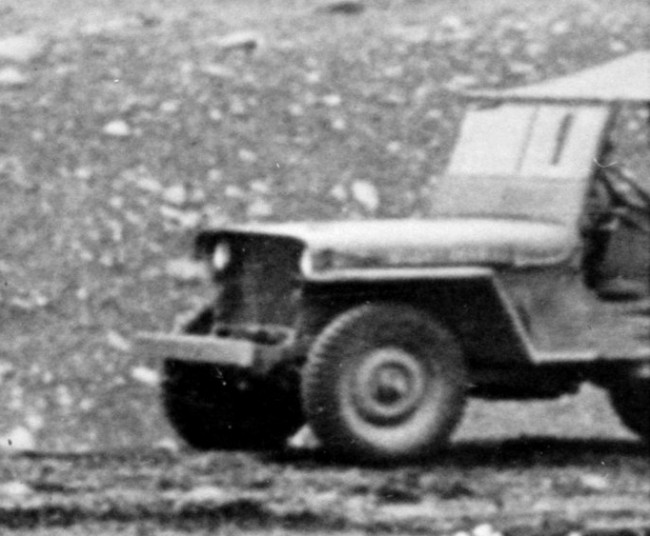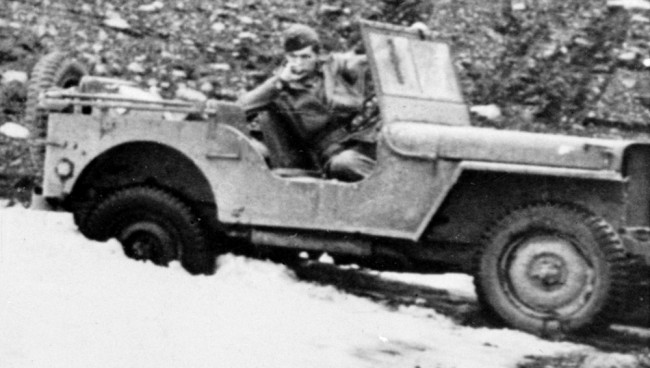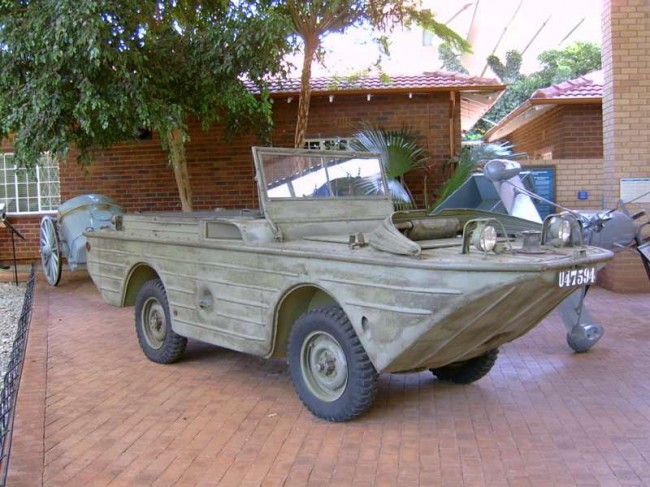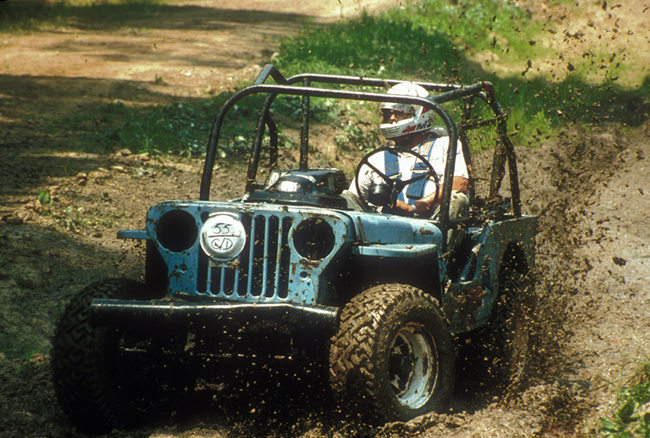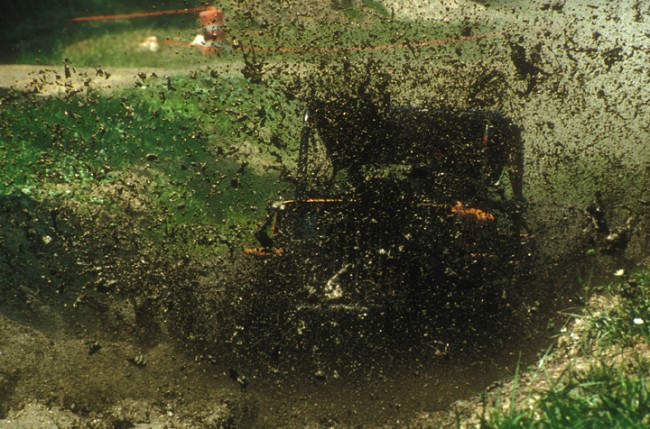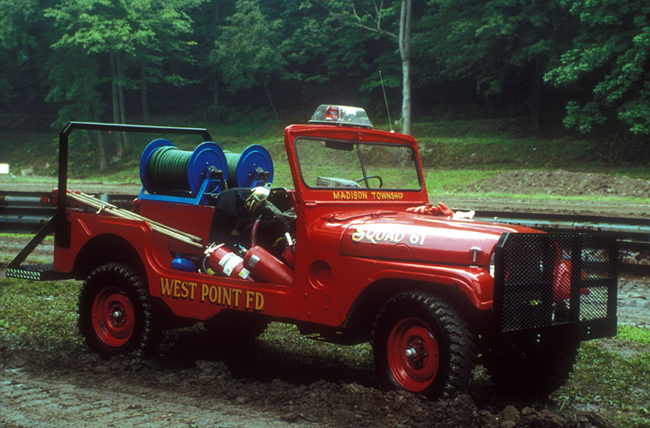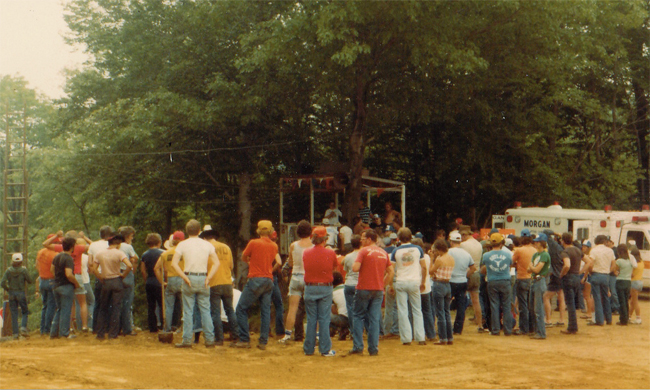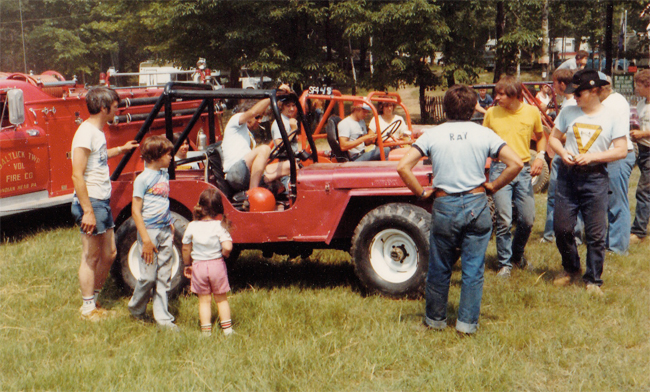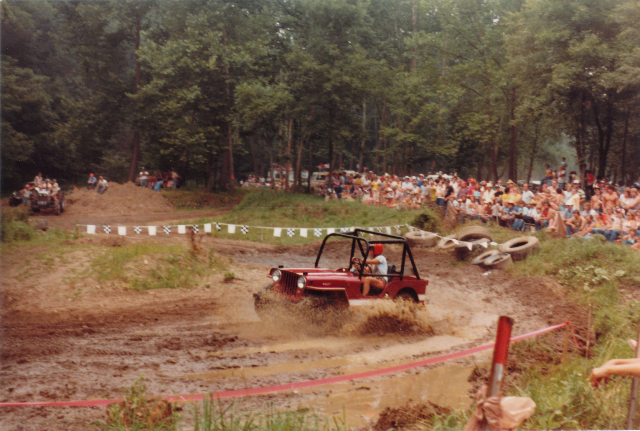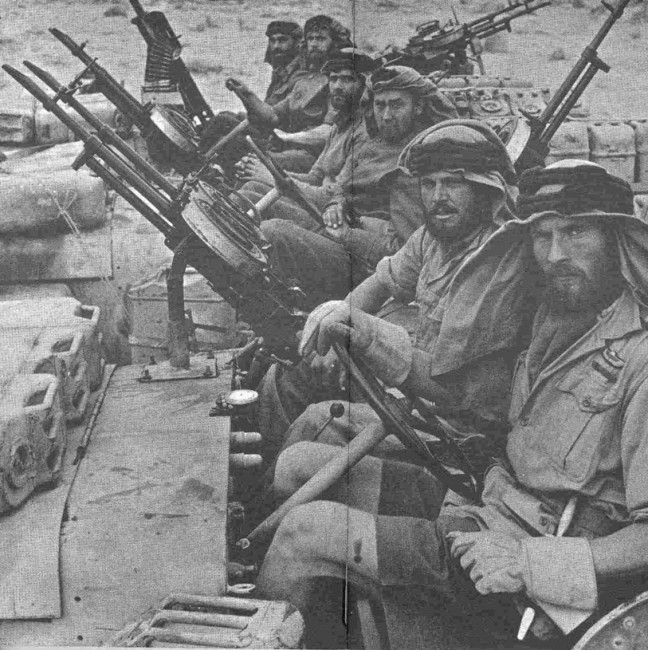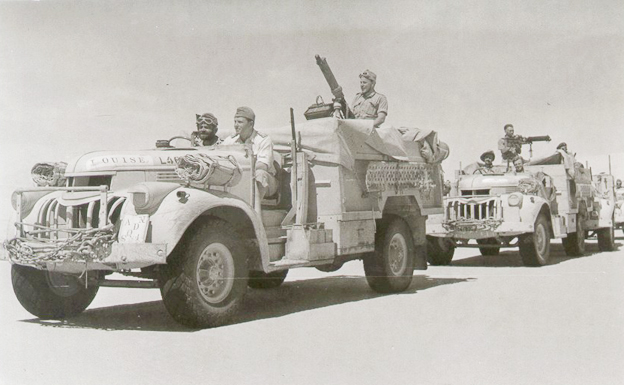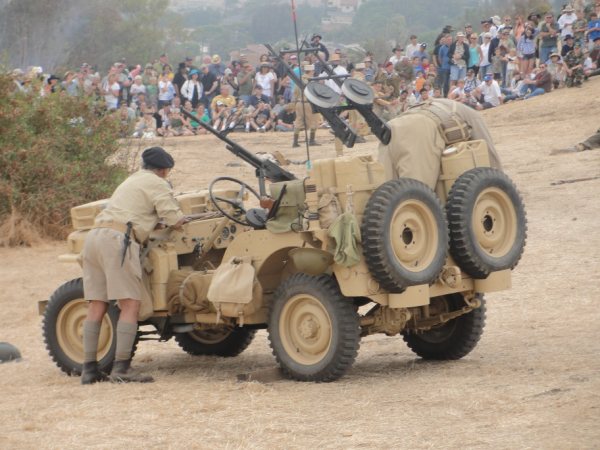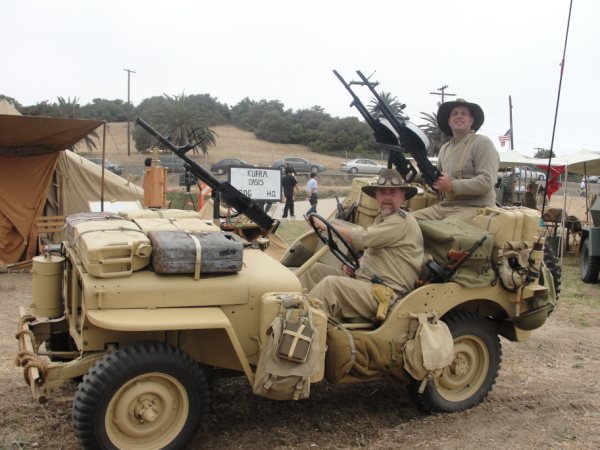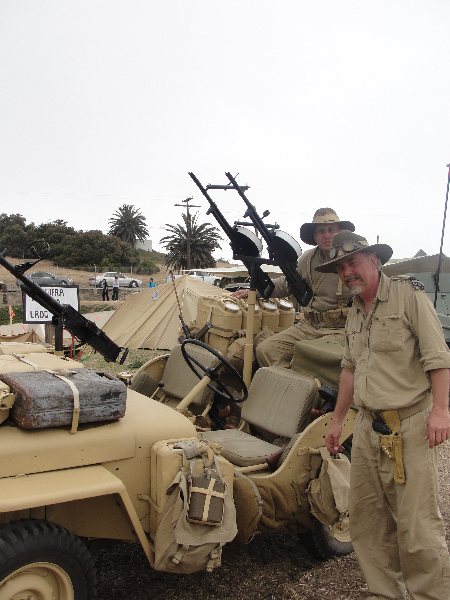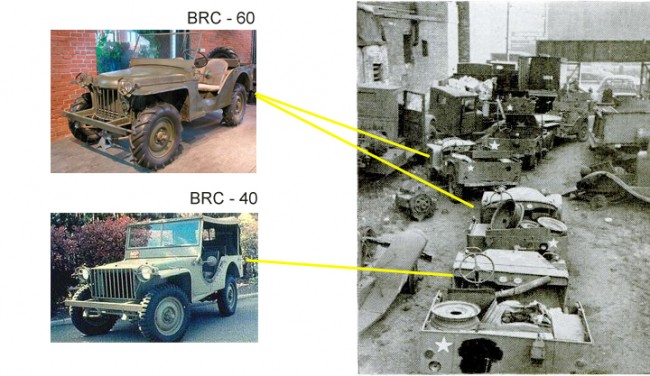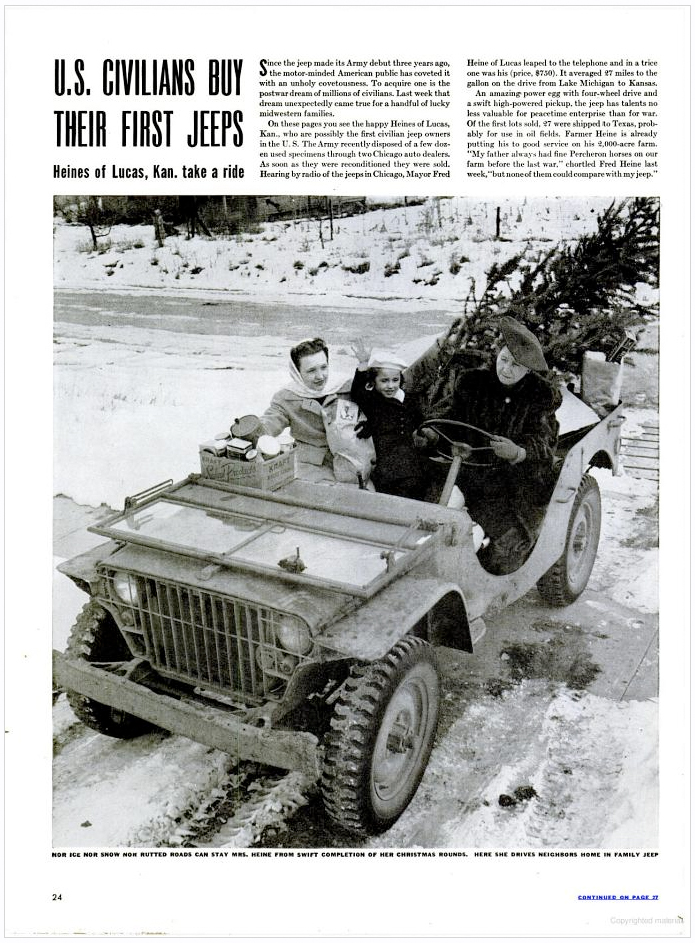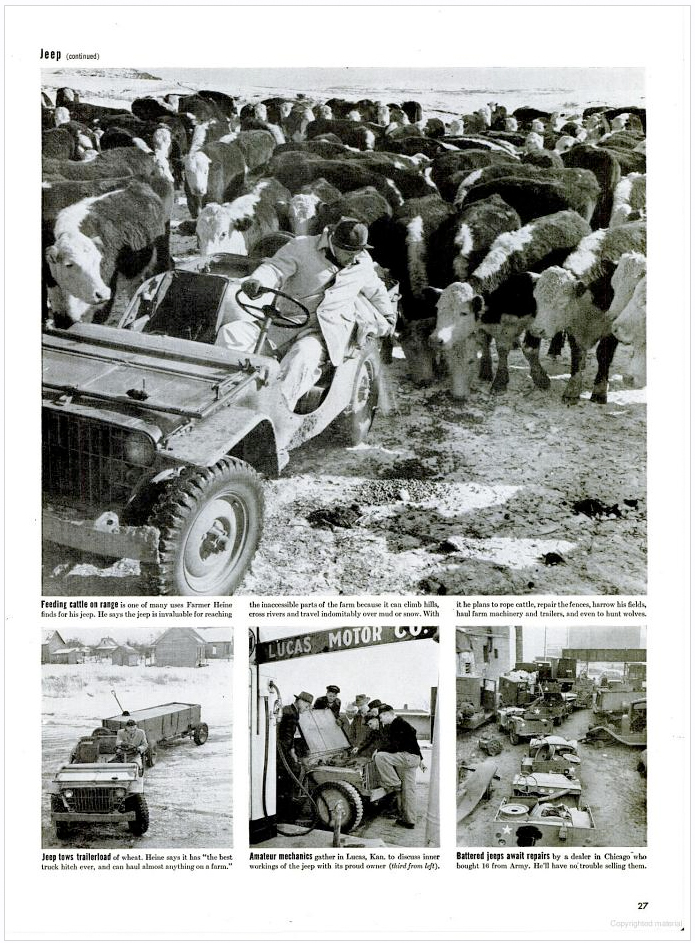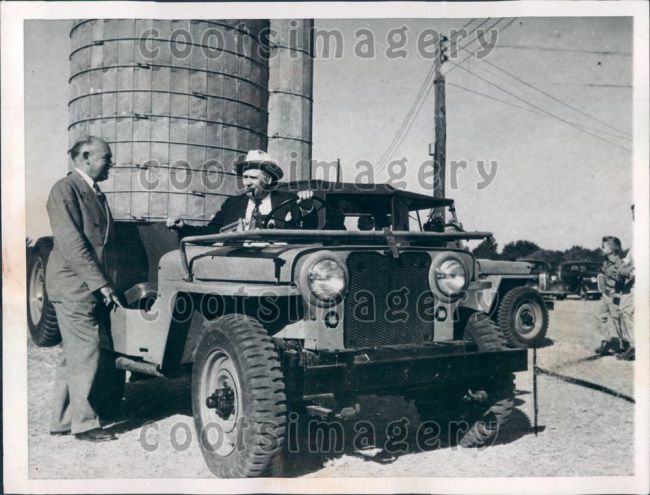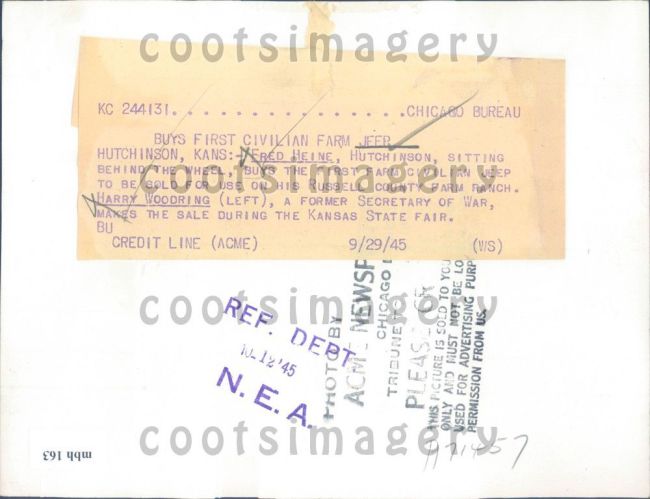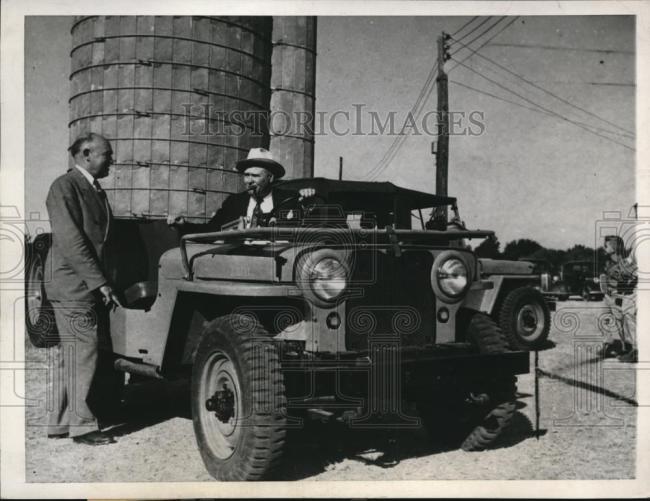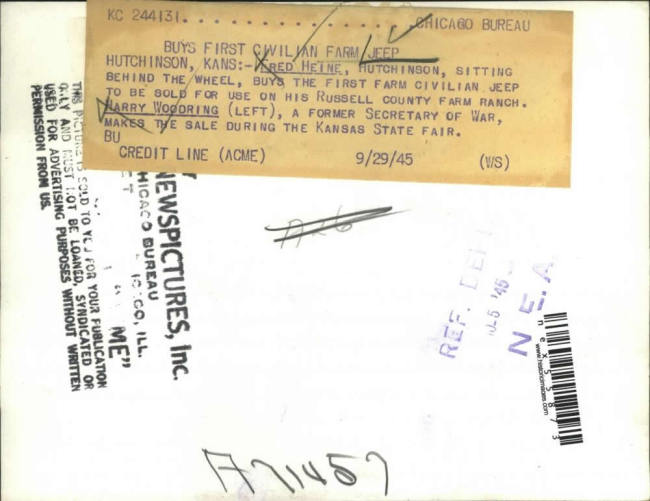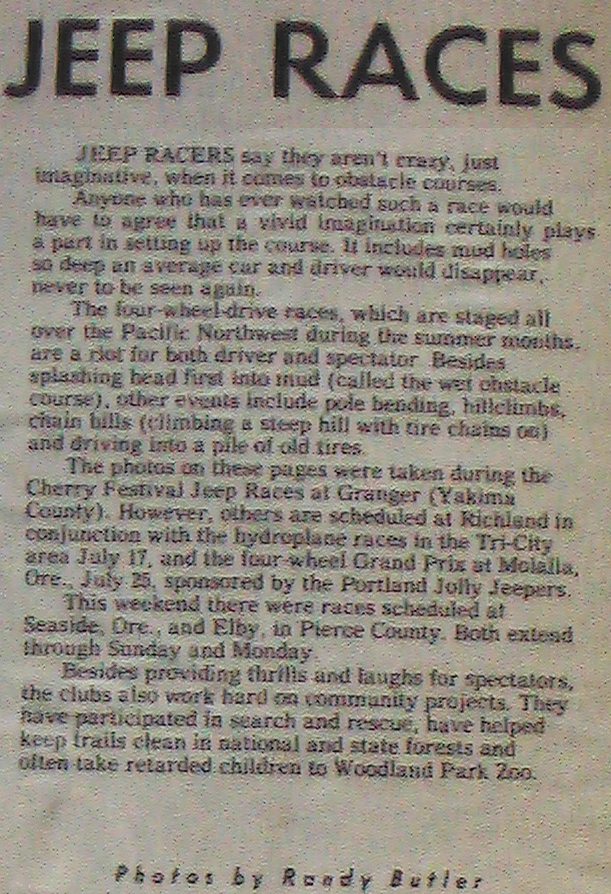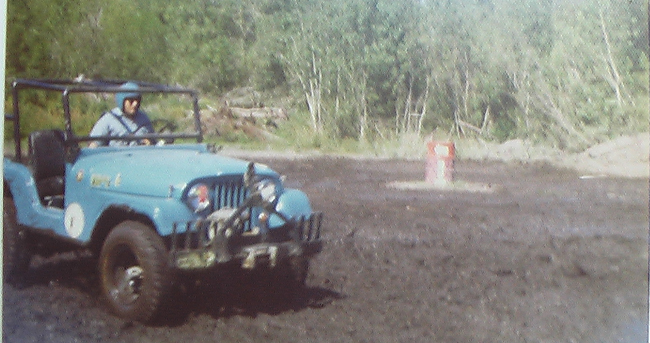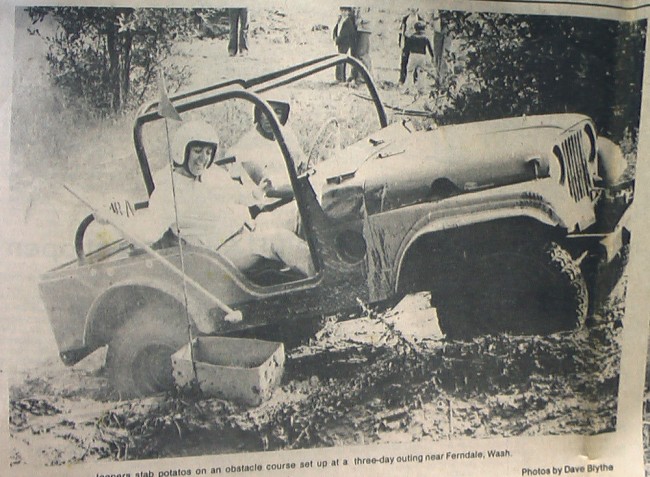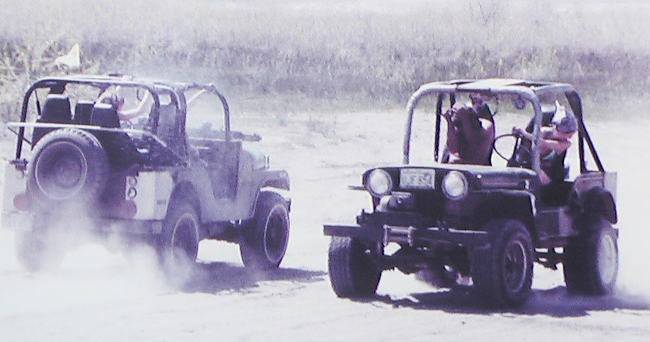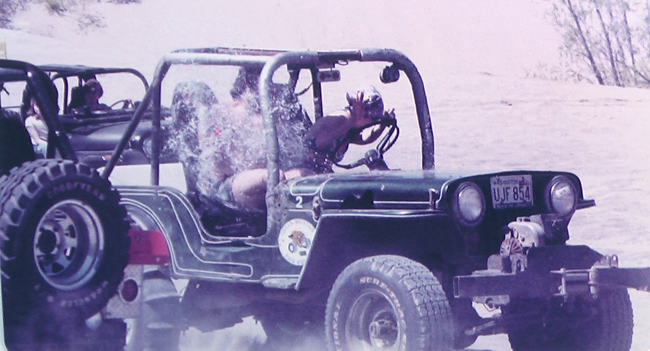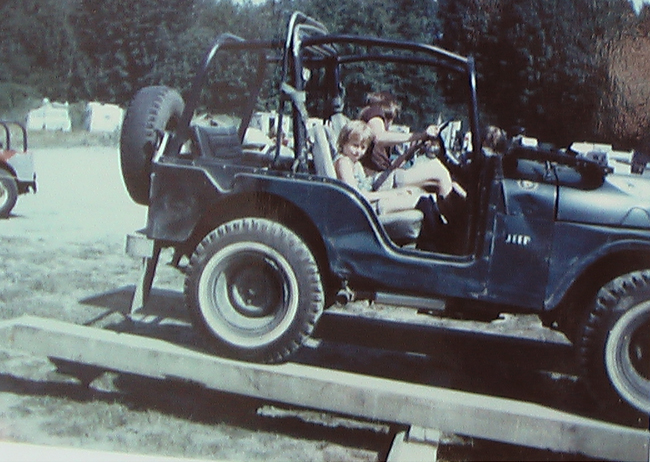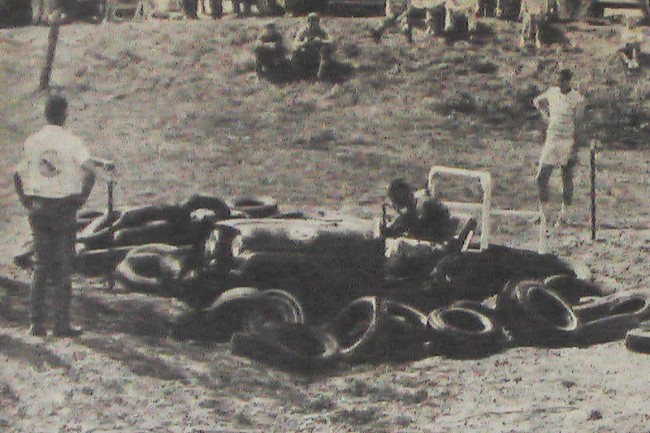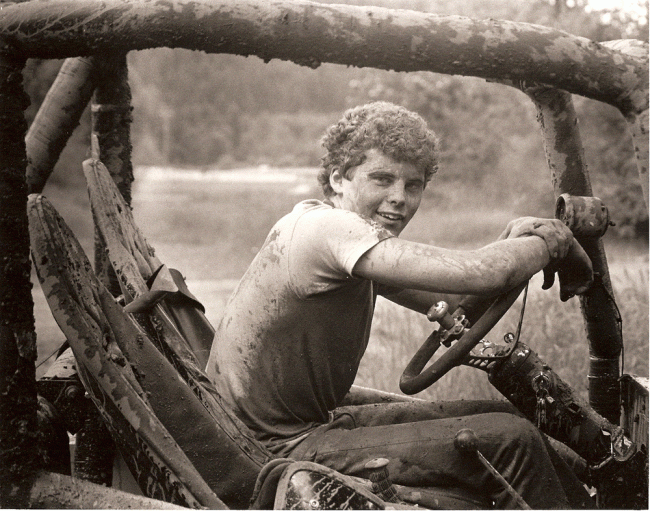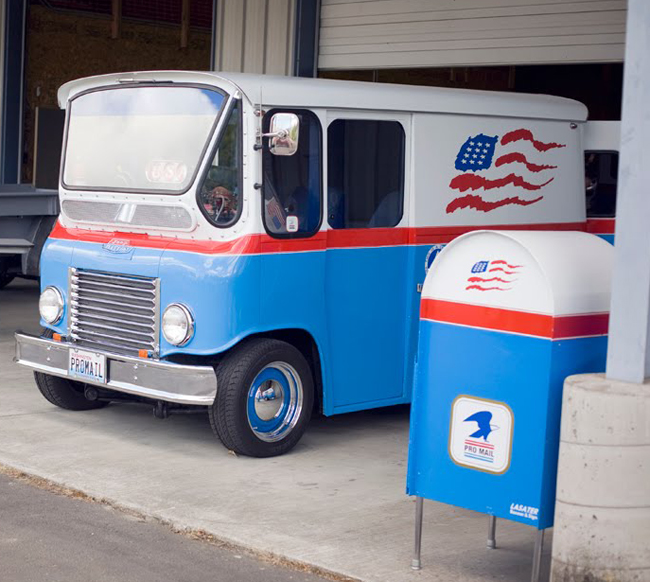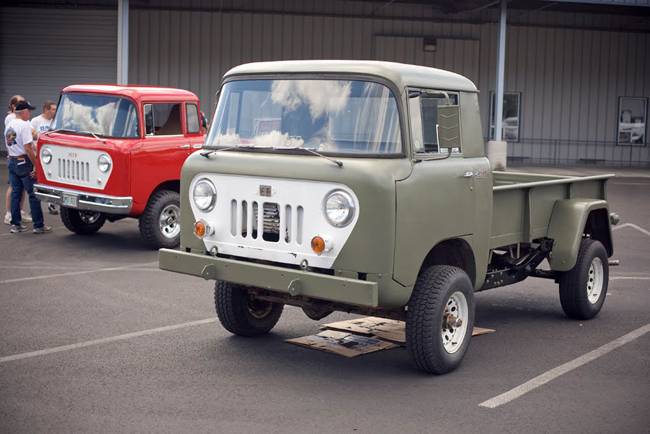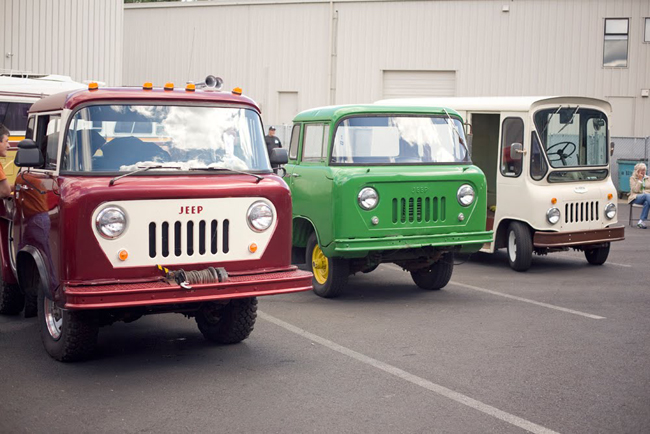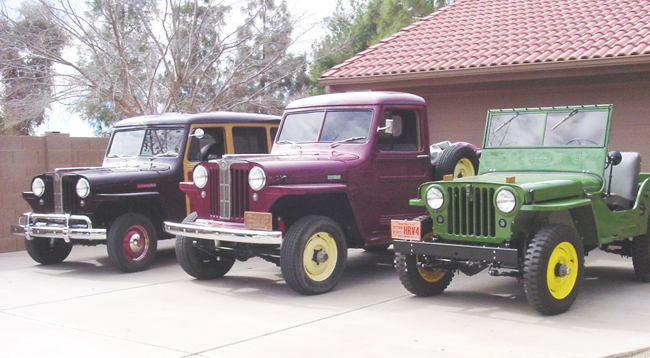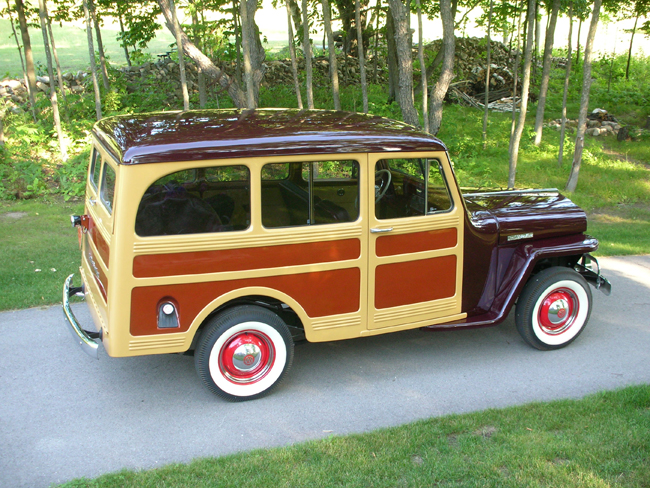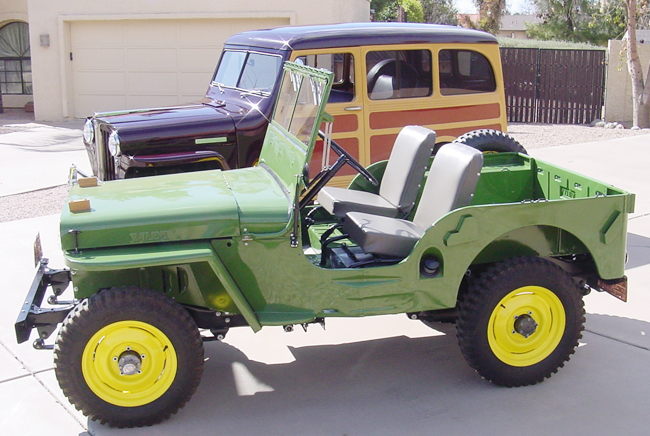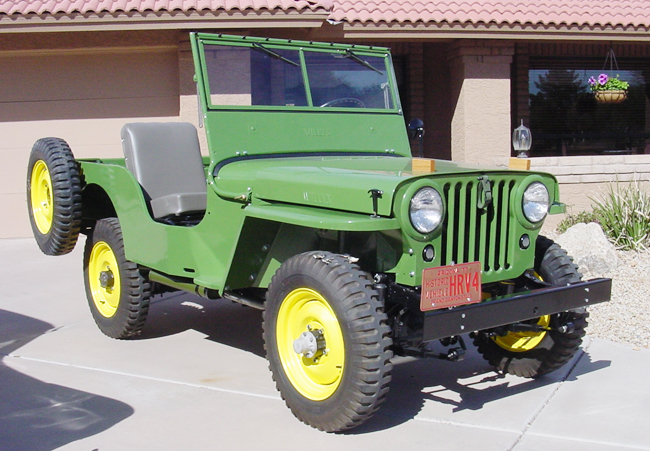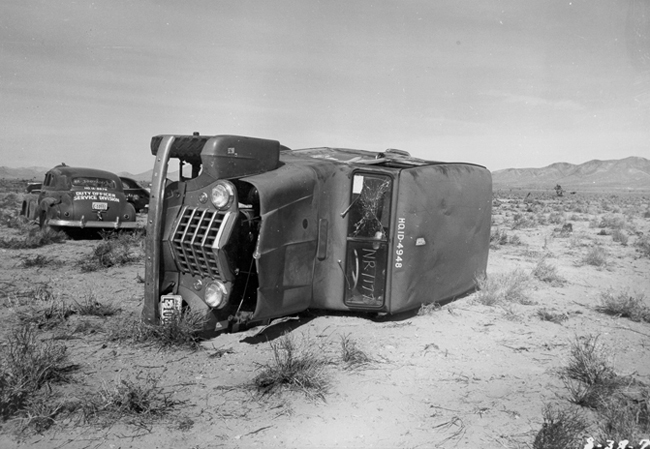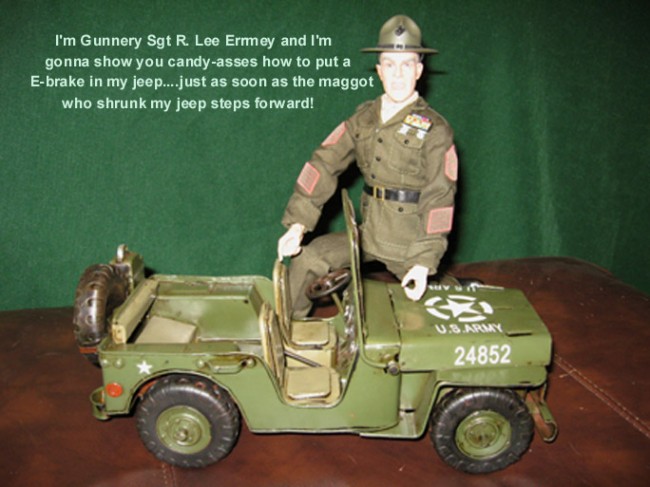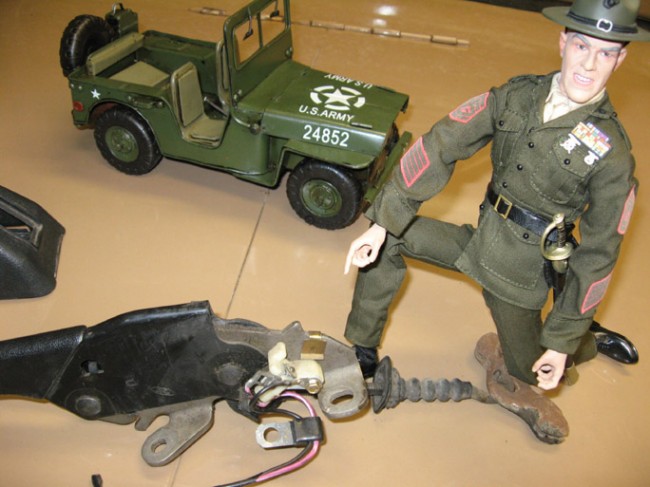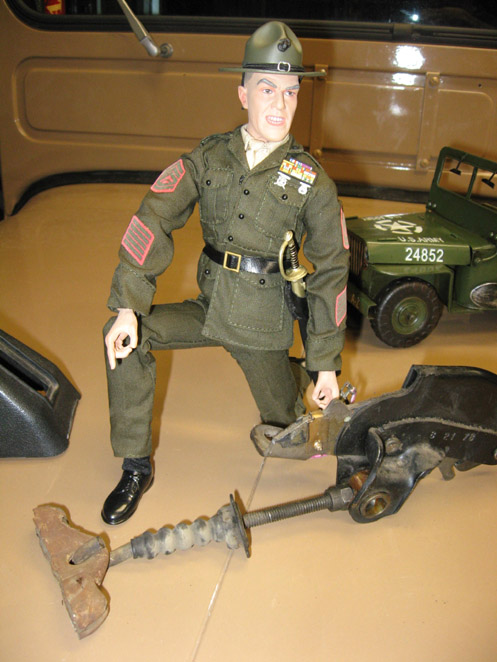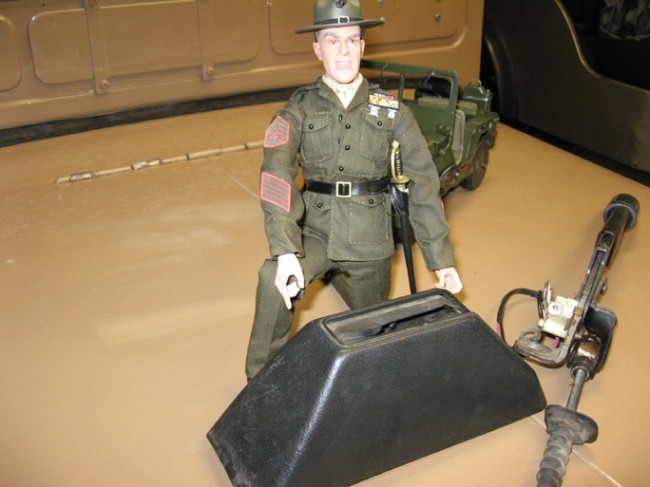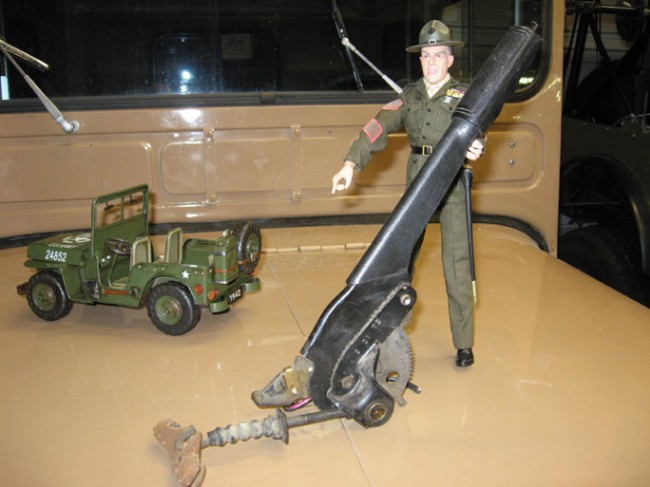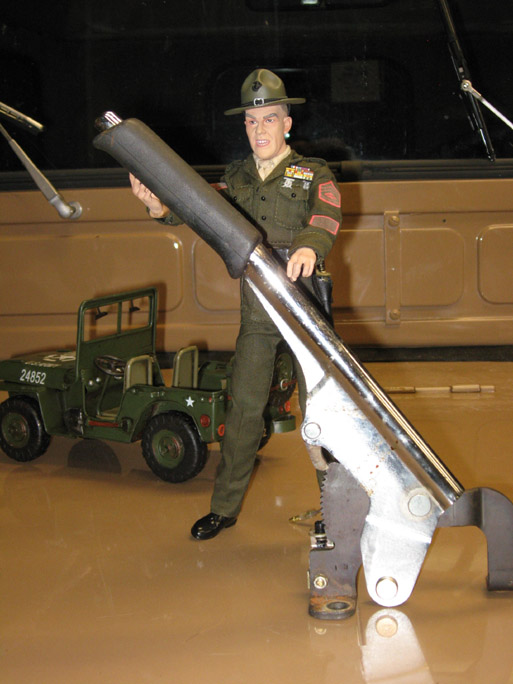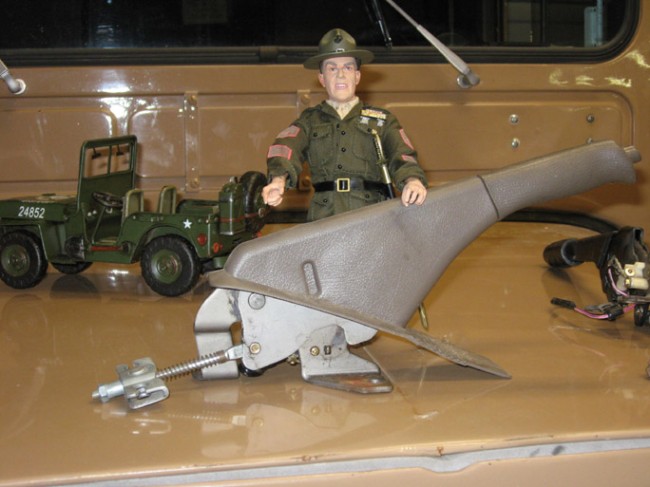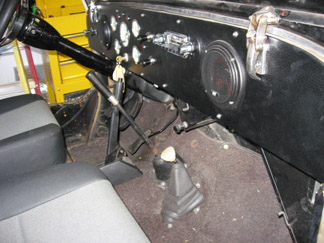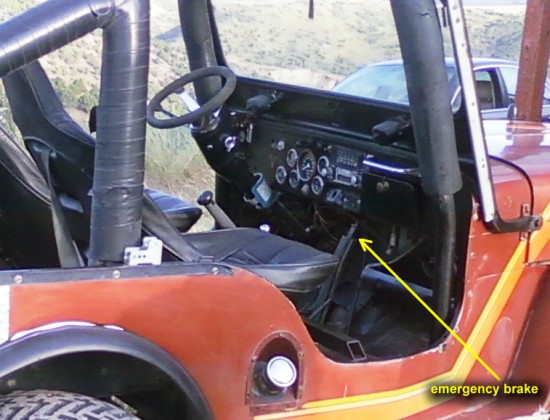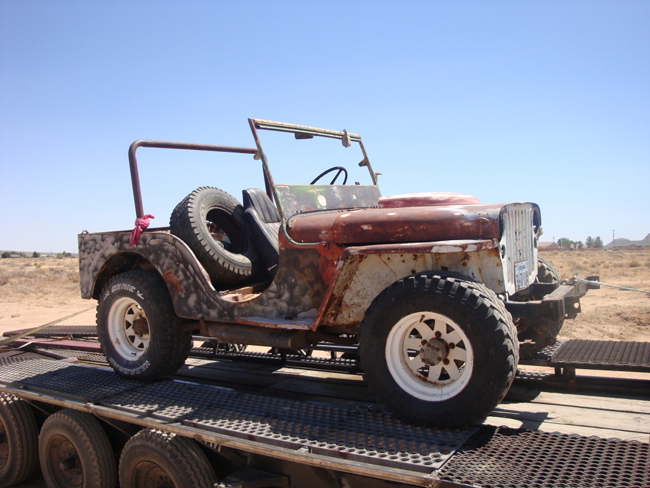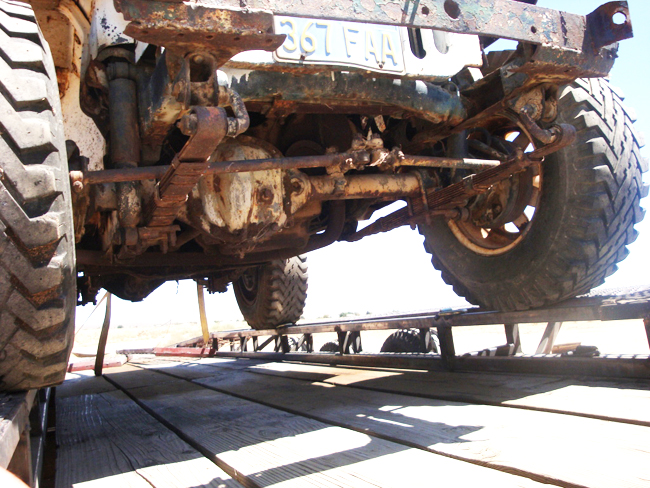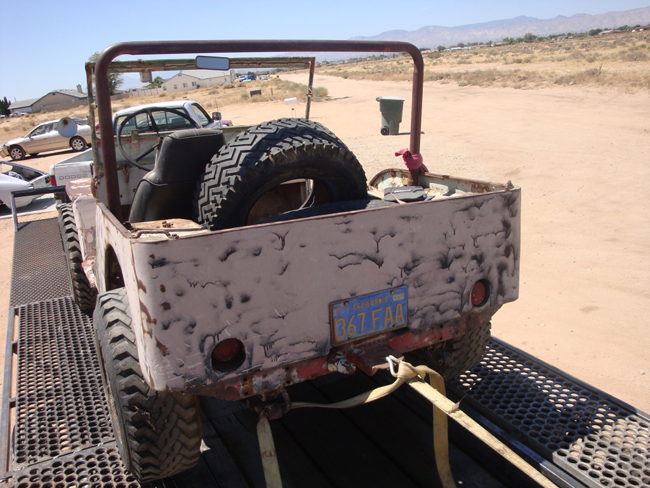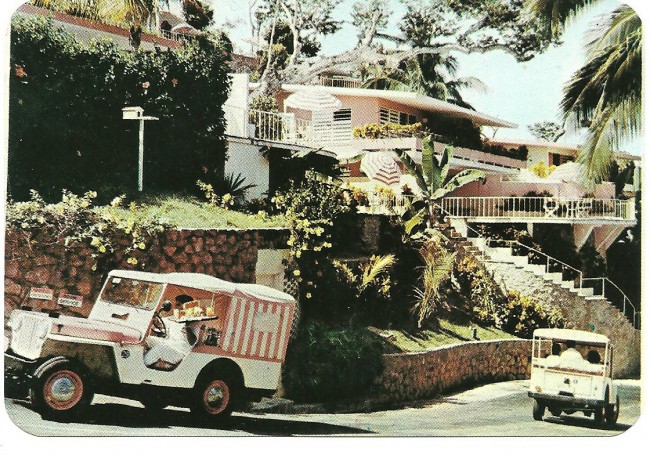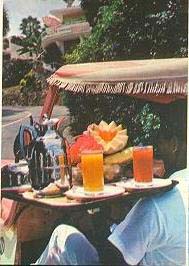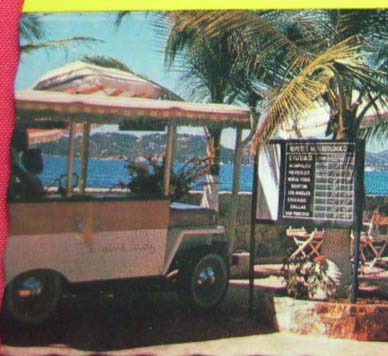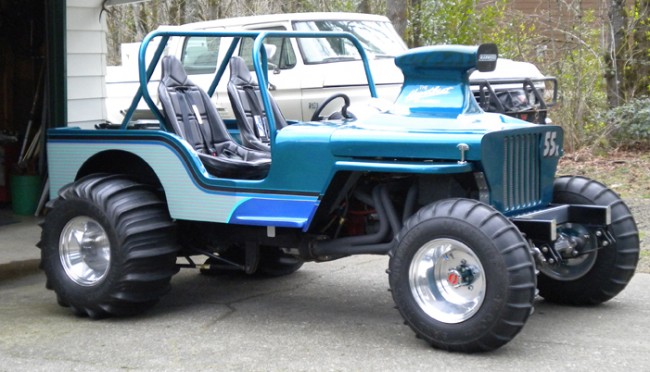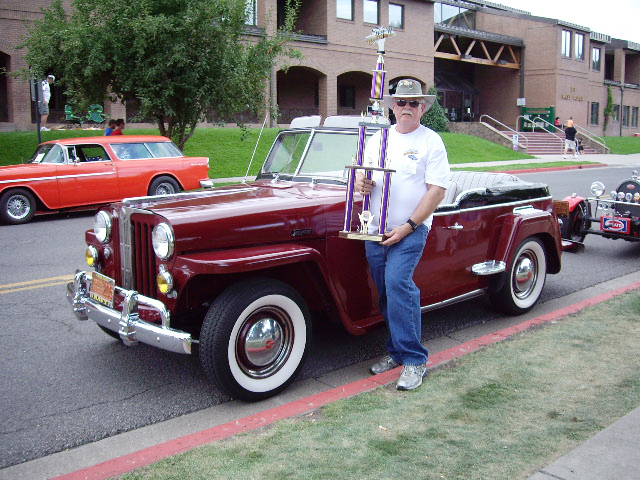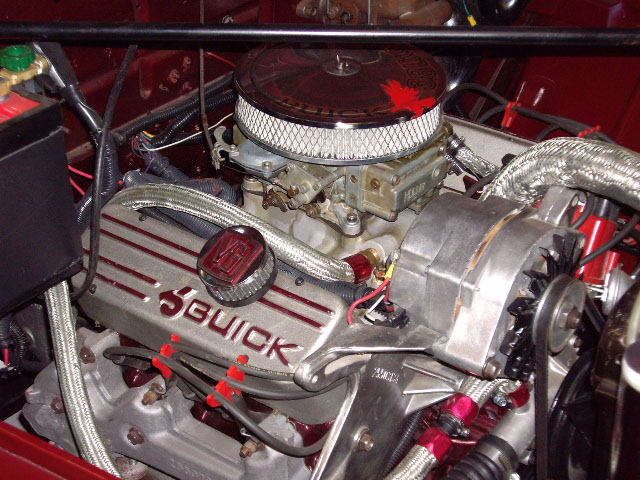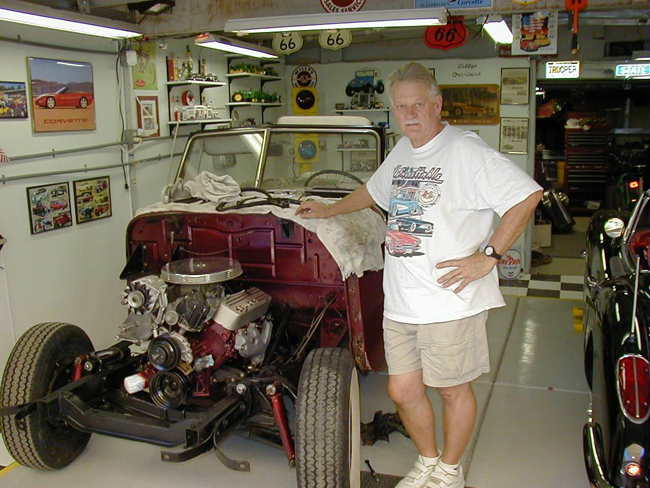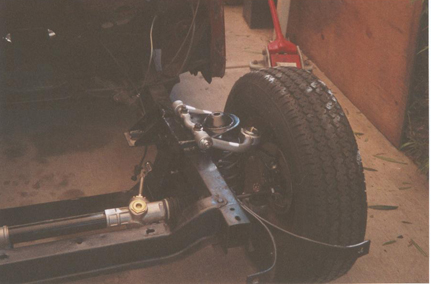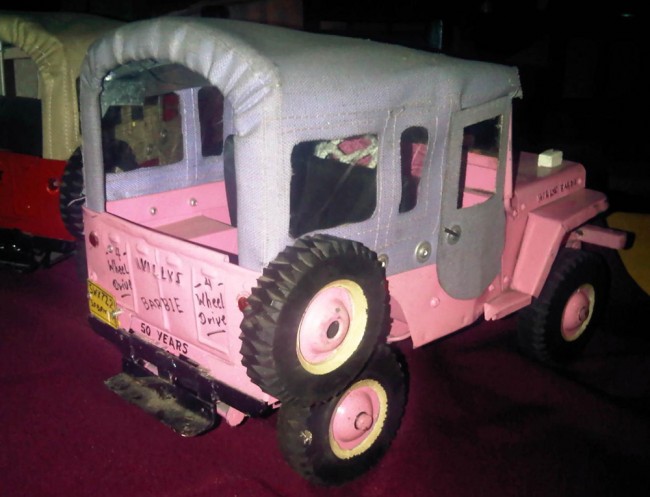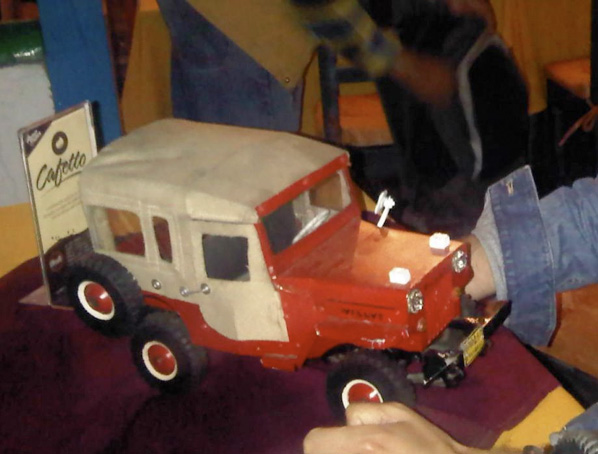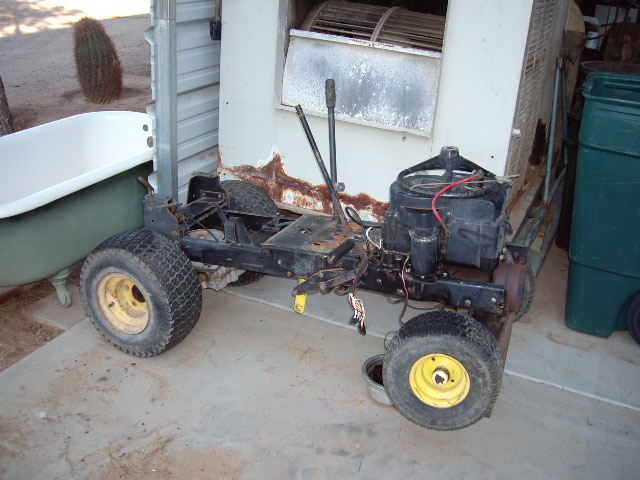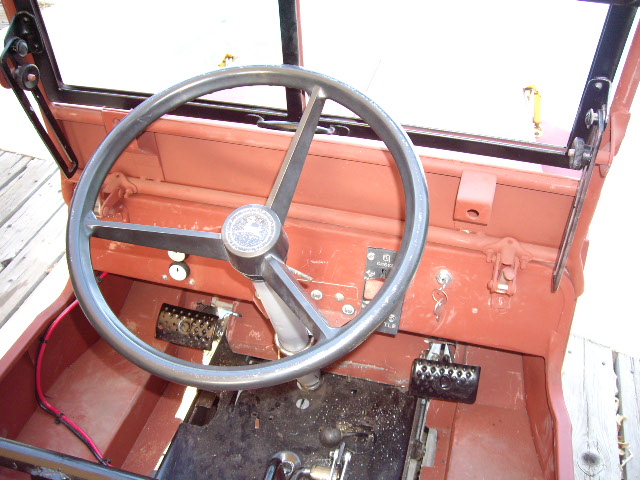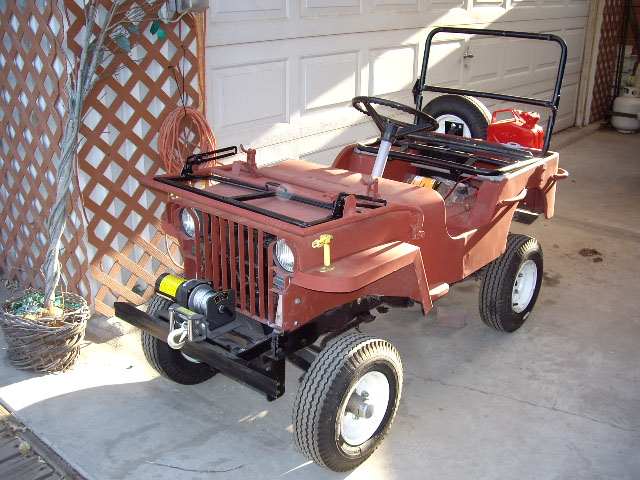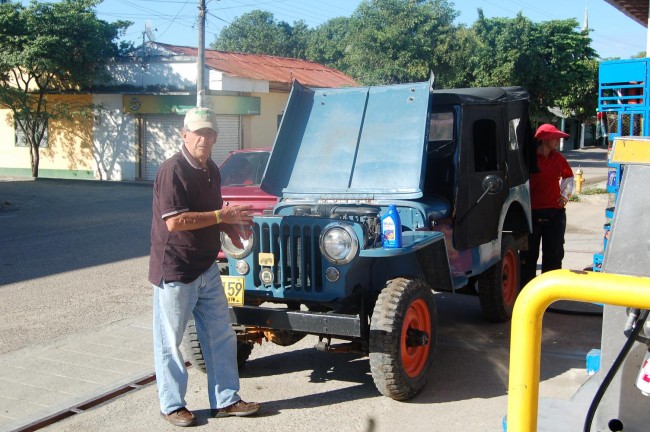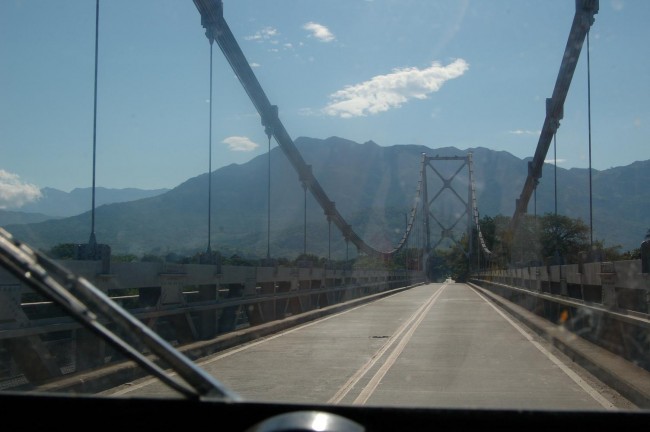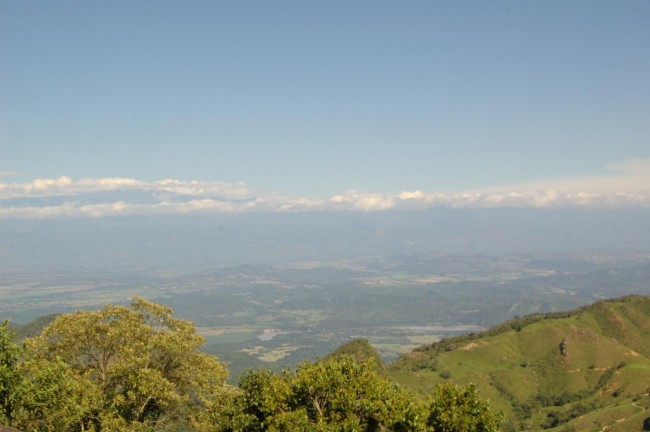Here’s an unusual color photo of soldiers posing in a Willys MA from Life Magazine. I couldn’t find the original source of this on the Life Magazine site (I stumbled upon it through Google).
Features Research Archives
Raymond Concrete Pile Company does Soil Research
UPDATE: Derek’s got much more information on the CJ-3B site.
This image was on Vulcanhammer.net, but no longer seems to be there. In it, you can see Raymond Concrete Pile Company’s Gow Division’s SPT rig using a PTO to bore a hole for soil research. This is actually an advertisement for the Jeep.
The caption with the image is, “The Jeep helps cut our costs by getting more done”.
And the text below the image is:
In building anything big, the first step is soil sampling. Gow Division of the Raymond Concrete Pile Company. 57-year-old construction company with projects around the world, keeps its 28 ‘Jeeps’ going eight hours a day in its work of investigating soil conditions to furnish information to architects and designers so they can determine the best type of foundations for construction projects of all kinds. Here is one of Raymond’s “Jeeps” with power take-off being used to operate an exploratory boring outfit.
The manager of Raymond’s Gow Boring division says: “We were the first to use the “Jeep” in soil testing work, and we have been using more and more “Jeeps” ever since. The “Jeep” helps cut our costs by getting more done. It can maneuver over rough ground in the country and get into tight spots between buildings in the city. It furnishes the pwoer for operationg our rigs and carries our equipment quickly from job to job so that we’re always ready to go.”
Here’s an example of a post hole digger. So, maybe they ‘dig’ with some kind of custom corer and then use the PTO to lift it (which is what they appear to be doing in the photo above)?
A Couple Slat Grille MBs and Marmon Herrington Tanks
Here’s an image from 1942 that Hugo spotted at wikipedia. The picture is high enough resolution that I was able to get a couple closeup pics as well.
History of Willys in South Africa from the NFI
Regular readers will remember Claus and his brother from the CJ-2As they restored in South Africa.
Claus also made contact with the Northern Flagship Institution, a national museums institution that falls under the auspices of the Department of Arts and Culture in South Africa. The NFI provided Claus with a detailed response that lists, based on their research, the jeeps that had entered the country.
Curiously, they don’t mention the SEEP (shown below) that is located at the South African Military Museum in Johannesburg. Gavin Walkers Willys MA site has a couple photos of it.
Based on Claus’s suggestion, I did a quick search of the CJ-2A Page Forum and learned here are a few other South African CJ-2A owners as well. So, I thought I’d publish this NFI historical information in hopes it helps others.
Thanks for sending it on Claus!
===============
From the NFI to Claus —
Thank you for your email query of 14 July 2008. The South African National Museum of Military History, a component of the Northern Flagship Institution does not have complete records of Willys Jeep purchases by the Union Defence Forces or by the later SADF. We have found some information which might assist you. Much research is still required to fully answer your query.
Since the Willys Jeep was manufactured in the United Sates of America, all issued American equipment to British Commonwealth countries came via the Lend Lease agreement. The Union Defence Forces had to work through the British War Department to obtain American Equipment via the Lend Lease. The first Jeep, a Willys MB seems to have arrived in South Africa in about October 1943. This Jeep was allocated the Union Defence Forces (UDF) number U 47505 and was used by Capt A A van Niekerk MC, Officer Commanding the paratrooper company of the newly formed SAAF Regiment undergoing training at Premier Mine, Pretoria.
During November 1943, a Willys MB Jeep – U 46-04, was used as a command vehicle during training in the Barberton district, by the Officer Commanding, S A Armoured Brigade, Brigadier C L de W du Toit.
At about the same time (November 1943 – April 1944) some Willys MB Jeeps were allocated to the 6 SA Armoured Division (6 Div) in training at Khatatba in Egypt, the numbers were small but unknown. We believe that 6 Div drew more Jeeps from British stores at Bari at the end April 1944, once they had landed in Italy. The numbers are unknown but this information may be at the SANDF Archives in Pretoria – sandfdoc@mwebco.za.
Photographic evidence shows that the following units used Jeeps in Italy:
During the advance of 6 Div from Cassino to Rome – end May to 6 June 1944:
6 Div Postal Unit
12 Field Squadron, South African Engineer Corps
North of Rome and into Gothic Line:
6 Div Headquarters
11 South African Armoured Brigade Group Headquarters
Prince Alfred’s Guard
First City / Cape Town Highlanders reconnaissance platoon were issued with Jeeps
The Natal Mounted Rifles also had Jeeps by October 1944
During the spring of 1945 and after 6 Div had broken through the Gothic Line the following units are known to have had Jeeps:
7/64 Battery of the Transvaal Horse Artillery
Imperial Light Horse / Kimberley Regiment
The war in Italy ended on 2 May 1945. On 14 May the 6 South African Armoured Division held a Victory Parade at the Monza Racetrack in which all their vehicles were paraded. After the parade the vehicles were handed in to the transport park. Later the vehicles were railed to Genoa to the 6 South African Armoured Division Vehicle Park. A small number of men chose to stay on in Italy after the other servicemen had been sent home to the Union. Many of these men had girlfriends and wanted to stay on and prepare the vehicles for shipping to the Union. The first ship left Genoa for Durban at the end of April 1946. The ex British equipment was shipped first in eleven ships. The American equipment was last to leave Genoa on SS Standridge on 3 May 1947, after much discussion on numbers and payment to the USA.
Only two Willys Jeeps and two 10cwt General Service Jeep Trailers were shipped to South Africa. A third Jeep, purchased by Captain D C Clarke under authority dated 23 September 1946 was shipped on the SS Samarina on 24 September 1946. This Jeep had the British War Department number WD 5662164. These are the only Jeeps to officially come from Italy to the Union.
In 1948, the UDF ordered two hundred and eighty nine Willys Jeeps, the model is unknown. These were allocated the U numbers . U 75800 – U 76088.
Forty three, 1951, Willys 7 seater station wagons were also ordered by the UDF and allocated the U numbers U 76177 – U 76219.
In 1960, twenty-five CJ-3B Jeeps were ordered as well as sixty-one of the more modern CJ-5s. Of the total eighty- eight ordered, only eighty-five were delivered at first, the rest arriving at a later date.
In about 1963/64 the SADF purchased one hundred and nine CJ-6 Jeeps. It is not known if they were manufactured by Willys Motors Incorporated or by the Kaiser Jeep Corporation.
In 1992 there were fourteen CJ-6 Jeeps at 4 Vehicle Reserve Park, Walmanstal, north of Pretoria. These had the following registration numbers.
BCL 953 M BCL 948 M BCL 941 M BCL 952 M BCL 939 M BCL 944 M
BCL 943 M BCL 937 M BCL 938 M BCL 945 M BCL 934 M BCL 950 M
The above listed Jeeps were powered by 4 -cylinder engines.
BDF 775 M and BDF 760 had 6-cylinder engines.
The Museum would appreciate any information you may find regarding Jeeps in South African service.
Yours sincerely
NORTHERN FLAGSHIP INSTITUTION
Incorporating — Transvaal Museum, National Cultural History Museum, SA National Museum of Military History, Kruger Museum, Pioneer Museum, Sammy Marks Museum, Tswaing Crater Museum, Willem Prinsloo Agricultural Museum.
Lisbon Ohio Races in the 90s
Bob admitted he couldn’t remember much about the races in these photographs, other than they were shot in the mid-90s in Lisbon, Ohio; but he got some great photos. Ok, truth be told, any photo that combines a flattie, desert dogs, and some mud is something I’d consider a great photo 🙂
And here’s a great M-170 Fire Jeep that was watching the action
Late 70s & 80s Racing in the EC4WDA
Inspired by the playday post, I had several emails about racing on the eastern shore of the US in the EC4WDA.
HOG explained how he used to race outlaw races to make money and those would give him money to attend the EC4WDA races for fun.
He writes, “I ran the East Coast 4 Wheel Drive Association from New York to Jacksonville Fla & from Ohio to the eastern shore. I would hit the outlaw races on one weekend & race EC4WDA with the winnings from the outlaw races. I miss doing that & the good friends I had back then.
I drove a 1978 CJ-5 with a 70 AMC AMX 360 motor with T-18 tranny & dana 20 transfer case. Its name was Wind Walker. It was Bright Red & I ran NOS on her to get me out of a class that was too crowded. My ex wife ran it in Powder puffs & won more than me.”
I asked HOG what an Outlaw race was. “Outlaw races were races for anything 4×4 put on by a local group. Mostly, they were hosted by Firemen. Best of all, they paid cash prizes (The EC4WDA didn’t pay cash, instead they gave you a $10 trophy).
I did well as my Jeep looked like a stocker jeep. In fact, I drove it as a daily driver & to the races. Also, when you’d get inspected by someone that had a Chevy or Ford hat you knew he didn’t know nothing about a AMC motor as they look so much the same. My 360 was mistaken for a 304 many times, with its the stock air breather (everything was covered in mud) sitting on top of a Holley spreadbore. I even had a cassette player to play my ZZtop, & a baby seat on the rear seat. Then all I had to do was just (key word) beat the guys I ran against.”
Gerald grew up in the EC4WDA with his brother and family. He forwarded me these pics from his days racing in the EC4WDA.
Here’s a scene familiar to all race days — the morning driver’s meeting:
Gerald tells me this is the line up for the Drags. I remember flatties just like these on the west coast:
You can see the family’s racer at rest and in action in the next two shots. If I remember correctly, the front loop from this race jeep is now in Gerald’s brother’s new build.
S.A.S. Ready for Action
As I was researching yesterday’s article on the LRDG, I wanted to learn more about the Bagnold sun compass. After reading the explanation, I’m am quite sure that I’m not yet ready to be thrown in the middle of the desert with a Bagnold.
However, as I did my research this unique ‘time’ piece on a French Sundial website, I happened to see the amazing image below.
Long Range Desert Group Preservation Society (LRDG)
EVENT: The LRDG Preservation Society will be participating its 2nd biggest event of the year October 2-3 2010 at Prado Dam Park in Chino Hills California. They are one of 85 different re-enactment groups from nearly every time period and culture in history. It is a Military Time Line Event which will feature everything from Roman Legionnaire’s to Viet Nam Re-enactors and many other periods in between.
Kim wrote me last week after seeing drafts of the “Africa SAS” T-shirt I’d like to produce (I am working on refining the shirt design btw). As the membership chairman of the Long Range Desert Group Preservation Society (LRDG), he’s particularly interested in the SAS jeeps and Long Range Desert vehicles. So, he introduced himself and the organization.
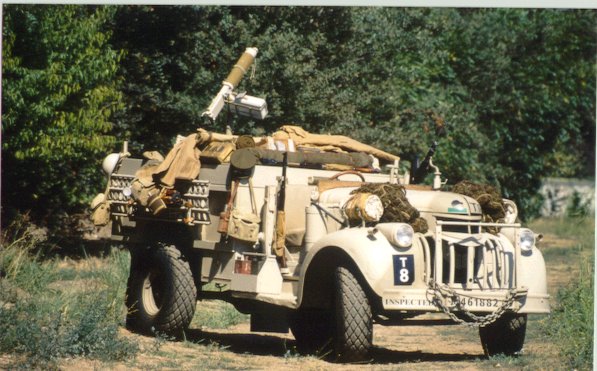 The LRDG Preservation Society is a non-profit organization established “to learn as much as possible about the unit, the men in it and the equipment and tactics they used. Then to share that information with all whom wish to learn. To that end this group has built a replica of a classic WWII LRDG truck (1942 Canadian Chevy, right hand drive, India format) and outfitted it with “historically correct” military equipment, gear, provisions, and uniforms. The vehicle was built by Rick Butler in Yreka California from several vintage trucks and parts from around the world. Converting a left hand drive vehicle to right hand drive was one of many challenges.”
The LRDG Preservation Society is a non-profit organization established “to learn as much as possible about the unit, the men in it and the equipment and tactics they used. Then to share that information with all whom wish to learn. To that end this group has built a replica of a classic WWII LRDG truck (1942 Canadian Chevy, right hand drive, India format) and outfitted it with “historically correct” military equipment, gear, provisions, and uniforms. The vehicle was built by Rick Butler in Yreka California from several vintage trucks and parts from around the world. Converting a left hand drive vehicle to right hand drive was one of many challenges.”
The Society has supporters and members throughout the world, including the US, England, Canada, New Zealand, Australia, Portugal, South Africa and more.
About the Long Range Desert Group:
During the 1930s, the British developed the idea of creating a motorized guerrilla/recon group in northern Africa to provide intelligence to British Forces. After studying the terrain and needs for such a group, the Brits formed the LRDG, which according to the LRDG website “was very much like a “private army”, formed to meet the particular conditions of desert warfare.” The LRDG was made up of volunteers and, because of this, they could wear beards and were given latitude that regular military soldiers did not have.
Learn more about the LRDG by clicking here and scrolling to the bottom of the page.
Kim’s LRDG S.A.S. Willys
I’ve seen them in old pictures, but Kim is the first owner of a Long Range Desert Group S.A.S. Willys to contact me and share pics. Of course, you can’t but help but think of the old Rat Patrol shows when you see these vehicles. After reading through the LRDG.org website, one of the things I’ve learned is that there was plenty of thought, research and recon work that went into the supplies these jeeps and truck would need to carry with them as they sailed long, desolate seas of sand.
Kim writes, “The jeep I bought is mechanically perfect. The previous owner put all his money into the motor, brakes and trans. The body on my jeep needs some help and eventually I will replace the rear and floor sections of the tub as there is some rust. Fortunately, It came to me painted in the proper color and had many extras including a Bagnold sun compass.
As a special addition to this jeep, I re-built a WW2 Italian de-milled M37 machine gun and converted it into a gas gun M.G. simulator. It sounds like a M.G. but no blanks are needed and it can not shoot a projectile. That is mounted on the front cowling. As I have been a machinist and tool maker for 30 years I machined a set of Twin Vickers machine guns out of aluminum for the rear mount. These are strictly dummies with no moving parts.
I did not buy this jeep to be a Trailer Queen. This is a re-enactment jeep and as far as I am concerned it looks like it just got back from Kufra Oasis and that is exactly what I want. My ultimate dream is to have 2 WW2 jeeps. The S.A.S (which is not street legal) and an American OD jeep that is licensed and ready to drive to work.”
And a couple pics of the Twin Vickers Kim made. In this pic, some basic outlines and contours have been created in the aluminum stock.
Here you can see many more details are apparent.
1944: Mayor Heine buys the first Jeep for Civilians
UPDATE 3: Cblynch posted an update to this information on g503.com site. He notes that Randy Withrow in Alabama owns the below GP and also owns all the original photos. Apparently, the woman driving the GP died a few years ago. (Thanks Simon). Also, you can see an additional photo from Bergs yard in this thread. Finally, to GP1942 from G503, I’m glad you are enjoying the content, but please add a link saying you found the info at ewillys when copying and pasting it into other sites.
UPDATE 2: After further review, and based on Lindsay’s comments, I would say that the first BRC is a BRC-40. The TWO jeeps in front of that are BRC-60s (made after the original BRC prototypes and before the BRC-40).
UPDATE: A reader named Lindsay was kind enough to provide an update to this story:
Lindsay writes, “An interesting note about the article with the mayor that purchased the GP in 1944. That vehicle was tracked down by Ken Hake years ago and restored several years later. The 3 smaller photo’s at the bottom bottom right is a photo of Bergs Jeep parts in Chicago note the first one is a Bantam BRC 40 the one in the front of that is a very early “round nose” BRC of which only one still exists and belongs to the Smithsonian. This proves that round nose BRC’s were released and sold to the public. I sure would like to find one of those in a barn.”
The military started selling jeeps to civilians in 1944. By all accounts, Mayor Heine, of Lucas Kansas, and his family were the very first purchasers of a Military jeep for civilian use. Here is a Life Magazine Article about the Heines and the related images from the January 4, 1944, issue of Life Magazine (page 24 & 27). I bet they wished the jeep came with a top and a heater!
NOTE: The jeep below is a Ford GP
====================
Fred Heine would late purchase an early CJ-2A, as captured in these press photos that landed for sale on eBay in 2014:
This is a second press photo of a photo sold two months ago. The caption is the same, though it has slightly different marks.
“1945 Press Photo Hutchinson Kansas Fred Heine buys Jeep for farm, H Woodring”
For comparison, here is what the photo and caption from October 2014 looked like:
PNW4WDA Playday and Races in 70s
This is a post I have wanted to publish for a while and finally got to drafting it last night. I have a lot of good memories of Playdays. One of my most powerful memories was a trip to Pendleton, Oregon, for Summer Convention 1975 (I think that was the year). It was located in the middle of a clearing in a forest: no buildings, just dirt, grass and trees. I was 10 and pal’d around with Tim and Steve Carter for most of the weekend. We were kids in a candy store, wandering around and through the various camp ‘cities’, made up of campers and tents and people and jeeps, meeting other kids and having a blast. There were an endless stream of club names and club stickers (on the side of the jeeps) that I’d never seen before. It truly was a different world …
Most of the images below came from the WWJC Scrapbook I borrowed a couple weeks ago. Because the book was too big to fit on my parent’s scanner, I had to snap photos of them, which explains some of the low quality.
It’s fair to call this a sampling of events, as I hardly went to all playdays. Feel free to comment on any I’m forgetting and I’ll add them to the post.
We’ll start out with this article in a newspaper about Jeep Racing from the mid 70s. I have to say I was a little surprised at the ‘retarded’ comment, which just highlights how fast language can change.
Jeep Stuffing: For the first event, let’s highlight this this oddball contest. Here’s Al “Ham” Hamilton in his old jeep Gypsy B. He and his Wife Barb were founders and deeply involved in the WWJC and the PNW4WA for many years. The remainder of the people piled on to this jeep appear to be WWJC members as well.
I couldn’t say how this was judged, but it reminds me of the Yipao events in Columbia where they stuff CJ-3Bs with just about everything.
Barrels: Here’s Al again. This is a classic event that still endures. Inspired by the barrel racing event you’d find at horse races, barrels were positioned in a triangle. The racer starts at a gate, circles around each as fast as they can, then heads back to the gate.
The Gypsy B was Ham’s road/race/trail jeep. As you can see, Ham didn’t even bother to take off the winch. He even scored some trophies in his jeep (well, at least one big trophy according to the scrapbook).
Potato Stab: In the Potato Stab, a racer races around a track and stops at each box of potatoes to allow the passenger to stab a potato, put it in a sack, and race onward. The fastest time won. There were variations of this event. One variation involved popping balloons instead of picking up potatoes.
Balloon Throws: This was just for fun. Two jeeps would pass each other and water balloons were thrown. I *think* this picture was taken at the Beverly Sand Dunes in Washington (near Vantage). In the CJ-5 is my mother driving and my sister riding shotgun, probably in the late 70s. This is Dad’s post rollover Jeep, note the cage has 4 loops with two in the middle. It’s the kind of cage you install in your jeep after you’ve rolled down a hill 5 times.
Balance Beam: The balance beam is pretty self explanatory. Again, this is my mom and sister (which is kind of weird, because I do not remember my sister or mother ever doing any of this). The object was to balance as quickly as you could. This had to be around 1973 — in other words, this is the pre-rollover jeep. I’m not sure why the side of the body on this jeep is so beaten up. I’ll have to ask Dad if he remembers why that is, though I suspect he might say something like “cuz your mom drove it” 🙂
Balloon Pop: In this event, a child drives a course and stops at a special spot. Once stopped, the child jumps out, runs to the balloon, pops it, runs back to the jeep, and completes the course. This jeep appears to sport a Bobcat fiberglass body, though it appears to be just a body shell.
Banana Course (no image): In the banana course, a driver drives the course with a passenger. At a particular spot, the driver stops and the passenger hops out and runs through a little obstacle, consumes a part of a banana, hops back in the jeep and then the driver finishes the course. There were probably variations of this as well.
Tire Pit: I suspect this is a precursor to the mud bog, but I couldn’t say. I don’t remember ever seeing this event in person. I suspect the object is to get out of the pit the fastest?
Obstacle Course: Still included in racing today, this course is a tight course, usually muddy, that racers try to get through as fast as possible. Below is an image of me after an obstacle course at the ORV Park Near Olympia during the 1985 Summer Convention.
Team Relay: This has been and continues to be a traditional end of the playday/summer convention race. It involves four teams of four jeeps and four drivers on one course. The object is to get all four drivers around the course one time. Each team is assigned a colored flag to make it easy to identify the teams while they are racing. The top two teams to finish a round advance to the next round. The team that wins the final round wins a trophy.
When I last raced, this event would take the entire day. There were many, many teams and people. It’s a fun event to participate in and watch.
The first time I ever ran this event (March 1985 on a cold weekend north of Everett), I broke the front driveline in my jeep in the first round, I broke the front driveline in Tim Carter’s race jeep Priority (version 1) in the second round, and I thought I had broke the front driveline of Jim Carter’s jeep Otis in the 3rd round (we lost, so we didn’t advance after that — and I was relieved!), but fortunately I didn’t break it. I have never broken a driveline since. Weird ….
Other events not shown:
Water Course: The object is to get around the course the quickest without spilling water held in a cup by a passenger. It’s a slow, but comical race. A derivation of this involves an egg; if I remember correctly, the passenger carries a spoon, on which they balance an egg through the course. If the egg falls off, they have to stop and can’t start forward again until the egg is back on the spoon.
Tonka Course: Kids put strings on their Tonka vehicles and pull them as they run through a course. There were other kid-specific courses that I don’t remember.
Backwards: The racer drives a course forward to a stopping point, then has to drive the course in reverse as fast as possible.
The Divorce Course: The driver is blindfolded. The passenger must tell the driver how to drive the course.
Cross Country Course: This is still in racing today and is a faster, longer course designed for faster speeds.
Hill Climbs: Self Explanatory. I haven’t seen one of these in a long time, but they got held occasionally. A derivation, based on the newspaper article above, is the chain hill. In this event, climbers put chains on their jeeps and try to climb hills. However, these hill climbs do not compare to those crazy Finnish Hill Climbers.
Drags: Self Explanatory.
King and Queen: This race is still run today. I’m not exactly sure when this was first run. If I understand correctly, this is an elimination race where 2 racers compete against one another. One racer starts on one half of the track and one on the other. Each racer completes the entire track. The first one to complete the race advances to the next round. The man that wins the final round is King and the woman that wins her final round it Queen.
Sprints: You can still find this racing occasionally (Here are some pics from earlier this year). This is head-to-head competition where a group of racers have to race a certain number of laps on a course. I never saw this at a playday, but did watch the Yakima Mud Races with were sprints in mud.
Top Eliminator: Only the fastest winners in certain events (such as the fastest cumulative times in the obstacle, cross country and barrel races for example) race in this race. There are no separate classes. The winner is the top racer (male and female brackets) for the weekend. The race track is usually a tighter version of a cross country course.
Pics from the 2nd Annual Northwest FC Get Together
The 2nd Annual Northwest FC Get Together was this past weekend in Olympia. Josue was kind enough to forward some images from the event and give his take on it.
Josue writes, “Last weekend was the first opportunity I have had to visit a Jeep get-together. It wasn’t a huge turnout but it was definitely worth visiting. The meet-up was in Olympia, WA and it was specifically for Forward Control Jeeps. This was the second year and only about 8 showed up, although I’m sure it will get bigger with time. It was fun talking to a few people and seeing a couple of them run.” Thanks Josue!
Colin’s friend Al & his Willys
Colin’s friend Al has got a nice collection of Willys. Colin forwarded a few pics of Al’s jeeps with some notes. Nice looking vehicles Al!
Colin writes, “I attached a photo of a CJ2A [al toy] that I did for a buddy of mine sitting on the hood of his August-built 1945 CJ2A with column shift, rebuilt with a lot of the leftover MB stuff that Willys used to get the first CJs on the road.
Al also has a 47 2WD wagon, a 49 Willys truck and a 49 Jeepster that is undergoing a repowering with a 55 Chrysler 331 Hemi, 727 trans, Mustang II front suspension and 56 Corvette rear end. Aside from body work and paint, Al does all the work himself and does an excellent job. The shot of the wagon with whitewall tires is the same wagon. Amazing what a set of wide whites will do for a car.”
Surviving a Nuclear Blast …
Just a few Updates Tonight ….
As a kid in elementary school, I remember climbing under my desk as part of our emergency drills (earthquake, nuclear blast, bully avoidance). But, I always wondered what I would do if there wasn’t a desk to dive under!
Now I know the government had already been planning for a lack of desks. Thanks to this image Alex spotted on Wikipedia, I now see that I just have to locate a Willys Wagon and dive into it for safety. Sure, it might get blown over, but it would sure be more comfortable than getting trapped underneath my desk (unless I was trapped under my desk with my sweetheart from 6th grade Michelle, but that’s a whole ‘nother story)! See the expanded image here.
Sam creates E-Brake Basic Training
No one can say that Sam and his wife Alecia don’t have a sense of humor. This tutorial had me laughing for a while today!
From Flatfender Willys Academy comes Sam’s explanation of the center emergency brake mod. …. Take it away Sam …
E-BRAKE BASIC TRAINING
2. This is a 78 Merc Capri E brake. There are 3 bolts that hold it in place. The wires are for a dash warning light. The hole to cut is just larger then the width of the fulcrum and slightly longer than the fulcrum travel.
3. The part in the image below goes under the floor and the cables from the rear loop through this cable guide. If the cable is too long, cut to length and use your cable locks. The best location for the brake is close to the seat.
4. This is the housing which is screwed down with screws. Use the housing to determine the location of E-brake.
5. Double check for clearance and reach by working lever up and down. If it feels good, install!
6. This E-brake is from a Hyundai. Most Japanese cars will work, but Ford is the easiest way to go.
7. This is also from a Hyundai, but boot needs to be modified. So you get busy with that E-brake while I give that maggot who shrunk my jeep a major malfunction….FALL OUT!
More Information:
It usually takes about a hour to install with 3 bolts, nuts, washers, and two cable clamps. Once you get the brake installed in the vehicle where you can grab it comfortably, hooking up the cable underneath is a no-brainer, no matter what year it is. I have also used this unit on drum type brakes.
In the image below, I’ve installed a brake in a CJ-3B with a CJ-5 Chassis. The installation is slightly different from that of the CJ2 etc. Total cost of the E-brake and cover at Pick-in-Pull for this project was $5.00. Cost of the clamps (2) and 3 bolts was $3.25 for a total of $8.25.
Comment by Dave …. This is the only other floor mounted emergency brake that I’ve seen. Unfortunately, the pic isn’t that good. But, you pull back on the stick to set it and push the button at the top to release it. You can see the rest of the pics related to this jeep here.
Is this possibly a GP or MA Body? California City, Ca **SOLD**
UPDATE: This appears SOLD, but was listed at $800.
I could be wrong, but the slopes and cut of the passenger and driver’s sides look very similar to a Willys MA, thought maybe a Ford GP as well?. This has been hacked up a bit, but it’s worth a look. Check out what appears to be an emergency brake as well.
“Clear title has orignal old style pink slip non op for 20 years but probably off dmv record now… 4×4 ran when parked 10 years ago”
Bruce Finds Some More Las Brisas Surreys
Bruce forwarded me these unusual and rare posts cards of some unusual Surreys (here’s a compilation of Surrey & DJ info). Bruce has attempted to contact the Las Brisas Manager to learn if they have a historian of sorts for their jeeps in use, but he hasn’t had any luck. If anyone has any Las Brisas connections, please let me know! Thanks for sharing Bruce.
Check out the guy driving the jeep, a stick no less, carrying a tray of food!
Brian writes, “ These 2 jeeps offer clues but also leaves one with more questions. The extended tub, tailgate, baby moon hubcaps, valance panels, and an absence of chrome bumpers. Also, there was no date stamp on the card, but it looks to be from the late/early 50-60s.
These 2 jeeps offer clues but also leaves one with more questions. The extended tub, tailgate, baby moon hubcaps, valance panels, and an absence of chrome bumpers. Also, there was no date stamp on the card, but it looks to be from the late/early 50-60s.
On the back of the postcard, written in both English and Spanish, it reads Room service by jeeps- unique at hotel Las Brisas in Acapulco where every room a has it’s own pool.”
DIRT: The Movie
In  an email today, Jeff mentioned a movie I had not heard of called DIRT (IMDB Link). Released in 1979, the movie follows a narrator around as he explores the wide-world of offroad racing. It’s got some especially great/scary clips of early auto racing. The rest of the movie shows all kinds of different offroad racing in the US during the late 70s (sand, water, hill climbs, baja, snow climbs, and more). One item I had hoped to see, but didn’t, was PNW racing, though I didn’t have time to watch every clip.
an email today, Jeff mentioned a movie I had not heard of called DIRT (IMDB Link). Released in 1979, the movie follows a narrator around as he explores the wide-world of offroad racing. It’s got some especially great/scary clips of early auto racing. The rest of the movie shows all kinds of different offroad racing in the US during the late 70s (sand, water, hill climbs, baja, snow climbs, and more). One item I had hoped to see, but didn’t, was PNW racing, though I didn’t have time to watch every clip.
Currently, you can watch the movie for free via YouTube. However, you can also order a DVD from Turner Classic Movies (about $11) or from Amazon.com (About $6).
Here’s the first YouTube installment. At the end of each installment, there is a link to the following installment (10 total).
http://www.youtube.com/watch#!v=MfByldRKTo4
Jeff’s Fiberglass (Bobcat Body) Flattie
After seeing some of the posts about the old Desert Dog and Bobcat ads, Jeff dropped me a note saying he’s been enjoying the old ads and old pics as it reminds him of the busy Northwest days of jeep clubs, playdays and racing in the northwest. So, he forwarded me a pic of one of his jeeps (he also has a sand drag jeep listed below for sale).
He’s been nice enough to let me post it. I really love the creative paint job — I haven’t seen anything quite like it.
Jeff writes, “This bobcat jeep was bought back in 1983 as a project. It was a body and a HUGE pile of parts, to which I’m sure your readers can relate. Currently, it runs a 355 chev w/ ford toploader 4 speed, a dana 20 case, a ford 9inch w/ 35 spline summers axles spool nod case and 6.00 gears. The front is a gutted mdl 27 w/ a mustang rack. The cage is chromoly. The car weights 2250lbs w/o a driver.”
Colin’s ’48 Jeepster
As I mentioned yesterday, besides his grandkids mini-jeep, Colin has worked on several different Willys. Here’s his Jeepster that was featured a couple times in JP Magazine, specifically the June 2007 issue and the January 2008 issue.
Colin writes, “Here are some photos of our 48 Jeepster. We have had this car for over 33 years and when we bought it, it had a non running Studebaker Champion 6 engine in it. Once we got it running and back in decent visual and mechanical condition, we drove it that way for many years. Around 1990, I stored it in our garage and worked on other vehicles and a house remodeling project (a happy wife makes for a happy home!). I did our Corvette restoration from 1994 until 1998. After I retired in 2003, I began putting ideas together about re-doing the Jeepster. I wanted a car that looked original on the outside, which it did already, but with an improved drivetrain and suspension under it to keep up with Phoenix area traffic. After a lot of research, I decided a Buick V6 was the way to go. I found a freshly rebuilt (still in the plastic) 1982 Buick 231 even fire V6 for a very reasonable price. I pulled the front sheet metal off the Jeepster and got to work. With an updated engine going into it, I chose to put a Mustang II front end kit with tubular A-arms, Ford disc brake rotors (I wanted to use stock Jeepster wheels, hubcaps and trim rings), and rack and pinion steering into the chassis. A buddy of mine and I did the majority of the front end work in a weekend. I used a set of engine mounts from Novak Engineering in Utah and bolted the engine to a 1967 Muncie close ratio 4 speed that was in my parts bin. For the rear end, I found a 1969 Ford Mustang 8 inch with 2.79 gears. That rear end is a bolt in for any of the 46-63 Willys 2 wheel drive wagons, panel deliveries and the 48-51 Jeepsters. I also used a front sway bar and on the rear, a Willys Jeepster/station wagon sway bar. I did upgrade the Buick with a set of finned aluminum valve covers from TA Performance, a 4 bbl Holley 390 cfm carb from a 65 AMC 327 engine and dual exhausts. The end result is a Jeepster that runs great( 1750 rpm at 65-70 mph), gets excellent gas mileage(about 26 at 65 mph) and handles like a sports car(better than our Corvette!). All of this work was relatively easy, even though it took me a while.”
In this first pic you see both his Jeepster and the 1960 Surrey he purchased that can be seen here. Colin has been restoring the Surrey as well.
Metal High Hood Jeep Toys from Colombia
As I looked through Sebastian’s pictures from his trip to Colombia, I noticed the two images with toy jeeps. It’s so shocking to see a toy made out of metal any more that they really stood out. I asked Sebastian about them and this is what he told me.
Sebastian writes, “yes they are metal jeeps and done with such detail that is hard to believe. Even the interior (not shown on the pictures) is done exacalty as the real thing. The cars have stearing wheals and shockers. I never saw those before, the only down side was the price: $75 US Dollars, it is probably worth it because all the labor that requires, but it is still expensive specially in an economy like Colombia. They had red, pink, and olive green. On the other hand, in most cities of Colombia you can find small pottery Willys, they are probably 2 inches long, 1 to 1.5 inches tall, made with clay and decorated Colombian style as the “Yipao”, those are probably $2 US Dollars each; you can see the price contrast.”
A Jeep for the Grandkids
Colin contacted me a few days ago. As a tech article writer for the Willys Overland Jeepster Club site, a restorer and owner of multiple willys, and, as you can see below, a very creative guy, Colin has a wide range of Willys experiences.
He’s been kind enough to share images and information from both his restorations and a friend’s as well. I’ll be publishing them over the next week. Tonight I thought I’d share this unusual project. Thanks Colin!
Colin writes, “Here are some photos of a little Jeep I built for my middle son and grandkids. It is a 1/2 scale Bemak 1941 Willys MB Slat Grille body mounted on a 1980 John Deere 111 lawn tractor chassis and powerplant. It has an 11 hp Briggs and Stratton engine with 5 speed manual transmission. I had to do a little cutting on the body to get it to fit the chassis, but most everything worked out pretty easily.
It has a 12volt electrical system with working headlights from Harbor Freight, WW II blackout lights for the front parking lights, and a WW II blackout lens with red LED for the taillight, a Harbor Freight 2000lb winch and a trailer hitch and receiver on the rear. I fabricated the front and rear bumpers to match the Willys stuff. I used EZ Go golf cart front hubs to get 4 bolt pattern for the Harbor Freight wheels and tires. I modified the rear axles to accept the 4 bolt wheels. I mounted a spare tire on the rear and fabricated a “jerry can” mount for the 1.5 gallon jerry can that is the fuel tank. I used the old clutch and brake pedals from the CJ3A and fabricated the shift linkage for the 5 speed transmission. The seat is a 1950s Willys station wagon driver’s side seat that I modified to do a double fold forward, where it covers the 12 volt battery. The windshield has Lexan inserted and a buddy made me a to scale WW II rifle mount for the back of the windshield. He also has restored WW II Jeeps, one MB that he just sold and the other is a 1944 Ford GPW US Navy Jeep. I painted it in WW II US Navy paint scheme, as our son is retired USN.”
See many more images by following the link below ….
Sebastian Returns from Colombia
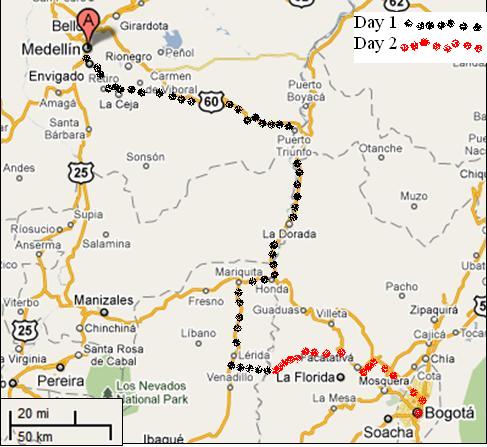 I hadn’t heard from Sebastian for several months, so it was a nice surprise to get an email from him. It turns out he just returned from a trip to his native country of Colombia.
I hadn’t heard from Sebastian for several months, so it was a nice surprise to get an email from him. It turns out he just returned from a trip to his native country of Colombia.
Among his exploits on vacation was a 2 day trip in a CJ-3A with his dad that took them from Medellin to Bogota, covering nearly 400 km (about 250 miles) with elevations varying between 1300 ft to 8500 ft.
Sebastian provides images from his trip as the Flat Fender Club of Butler’s website. I’ve linked to a couple below. I’m hoping to sneak into his luggage on his next trip to Colombia — it’s a beautiful place. Thanks for sharing Sebastian!
The ‘CJ-5′ Overlander at earlycj5.com
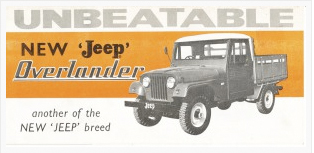 The earlycj5.com site recently published some great brochures about a CJ-5 truck called the overlander which was available in Australia. Check it out! (Thanks Dan).
The earlycj5.com site recently published some great brochures about a CJ-5 truck called the overlander which was available in Australia. Check it out! (Thanks Dan).
Installing Rack and Pinion Steering on an old Willys (4 hours)
UPDATE: Sam has provided some detailed instructions (which will replace mine) and will also be sending some pics when he completes his next installation.
One idea Sam has shared with eWillys readers was the rack and pinion steering modification he has been doing. He describes this as a pretty straight forward installation that can replace the stock steering in any flattie. Sam says this takes him about four hours to complete. Pics are forthcoming on this modification.
Sam describes the process as follows:
1) Remove Steering: Take out the existing steering mechanism and the mounting plate.
2) Remove Drag Link: Remove drag link from old box to bell crank
3) Layout Straight Edge: With front wheels straight ahead, use a straight edge (anything will do, I use a piece of conduit) and lay one end on the passenger side tie rod from the spindle and the other side on the frame rail directly above the drivers side tie rod end at the spindle This will give you the approximate location for the rack and pinion. DO NOT USE original box location as this will put the cross link through the engine block.
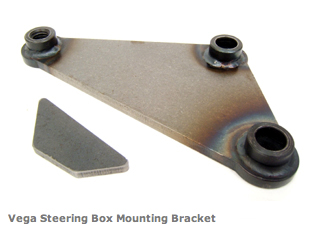 4) Where to Mount Vega Plate: Take the Vega box mounting plate (The plate Sam uses is this plate from Unisteer.com) and using a large C-clamp, attach to frame with the top of the plate even with the top of the frame. This will put the mounting holes in the right place. You will notice the top two holes are inside the opening of the frame and the third hole is below the frame as it should be.
4) Where to Mount Vega Plate: Take the Vega box mounting plate (The plate Sam uses is this plate from Unisteer.com) and using a large C-clamp, attach to frame with the top of the plate even with the top of the frame. This will put the mounting holes in the right place. You will notice the top two holes are inside the opening of the frame and the third hole is below the frame as it should be.
5) Temporarily Mount Rack: The rear edge of the Vega plate should be ONE inch ahead of the line from the tie rods towards the front of the vehicle. NOTE….at this point, it is very important to temporarily mount the rack (You may use longer bolts to clear the C-clamp). Once mounted, move the wheels all the way to the right and make sure you have at least one inch clearance between the cross link from the Rack and the oil pan. Do the same with turning the wheels to the left. If you have the proper clearance, you have the right location for the mounting plate for the Rack and Pinion.
6) Weld Plate to Frame: Weld the Vega plate in place and be sure to use the supplied gusset ( I use two of them, as I have found that with one gusset, there is a chance for mount twist under harsh conditions such as four-wheeling……strongly suggest you do the same grin grin)
7) Attach Rack and Pinion: Bolt the Rack and Pinion in place and attach the cross link to the Rack and with the Rack centered and the wheels dead ahead, mark the cross shaft for cutting allowing for the length of the tie rod end. Now you may cut, thread, and install the tie rod. The unit Sam uses is this cross steer rack from unisteer.com (that link is dead, but this may be the one). 
8) Determine Steering Rod Length: Using the conduit, determine the route from the bottom of your steering column to the Rack and Pinion. This varies with engine and frame variations but is very simple. Usually all that is required is to determine if the column needs to be shortened or if a double joint is needed. At this stage, determine what your shaft is…..splined, D shape, square, etc. This will determine which joint to use. If round, (with roll pins) I strongly suggest you modify it to D-shape for strength. Sometimes you have to use TWO rods from the column to the box. If so, USE ROD SUPPORTS before and after middle joint. You can get everything you need from Borgson Joints. If you choose the shorten your column (to use One Rod) you can can get the necessary seal and bearing from them too.
9) Double Check Everything: Double check everything for tightness and clearance and YOU ARE DONE — smile, have a beer.
This sounds simple and it really is, I’ve done soooo many of them, that I can do it start to finish in four hours. If anyone still needs help, just call me or Dave and I’ll be more than happy to walk you through it. The last one I did cost $612.42 for everything, Somewhat cheaper than regular boxes and a whole lot better looking and steering.
If properly installed, you’ll notice the steering much tighter while driving and capable of easily turning under the weight of even a V8 when parked.
